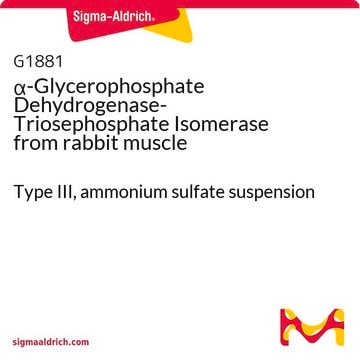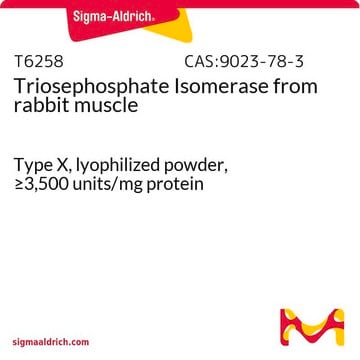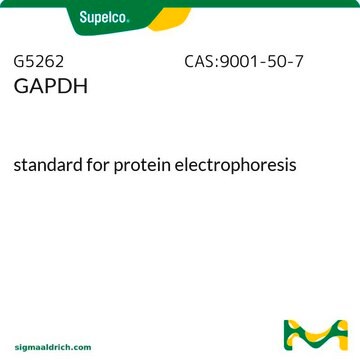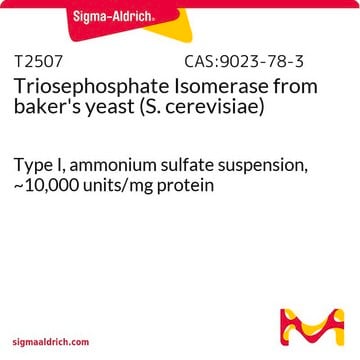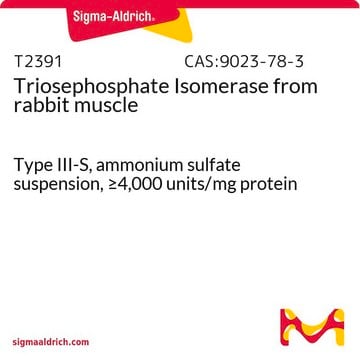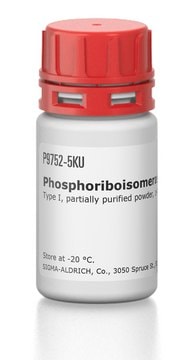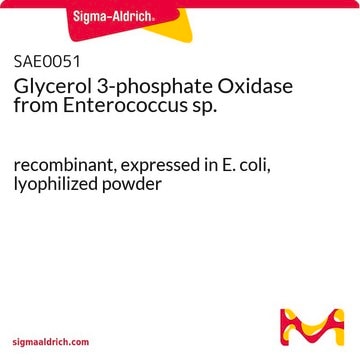P7634
3-Phosphoglyceric Phosphokinase from baker′s yeast (S. cerevisiae)
ammonium sulfate suspension, ≥500 units/mg protein
Synonyme(s) :
PGK, Phosphoglycerate kinase, 3-Phosphoglycerate kinase, ATP:3-Phospho-D-glycerate 1-phosphotransferase
About This Item
Produits recommandés
Source biologique
bakers yeast
Forme
ammonium sulfate suspension
Activité spécifique
≥500 units/mg protein
Conditions de stockage
(Tightly closed)
Concentration
1.0-10.0 mg/mL
Activité étrangère
Glyceraldehyde-3-phosphate dehydrogenase ≤0.1%
Conditions d'expédition
wet ice
Température de stockage
2-8°C
Vous recherchez des produits similaires ? Visite Guide de comparaison des produits
Description générale
Phosphoglycerate kinase (PGK), a glycolytic enzyme, is isolated from a broad variety of organisms. This typical hinge-bending monomeric enzyme is well-conserved among the three domains of life. The enzyme is made up of a single folded polypeptide chain that divides into two nearly identical domains, each linked by two -helices (-helices 7 and 14) and separated by a deep cleft. This arrangement gives the enzyme its distinctive bilobed structure.
Application
- to study low molecular weight GTP-binding proteins and mechanisms of inhibition of glyceraldehyde-3-phosphate dehydrogenase
- in the coupled assay to measure the backward activity of purified rabbit skeletal muscle nicotinamide adenine dinucleotide (NAD+)-dependent glyceraldehyde3-phosphate dehydrogenase (GAPDH)
- in the assay of glyceraldehyde-3-phosphate dehydrogenase
Actions biochimiques/physiologiques
Définition de l'unité
Forme physique
Remarque sur l'analyse
Produit(s) apparenté(s)
Mention d'avertissement
Warning
Mentions de danger
Conseils de prudence
Classification des risques
Eye Irrit. 2
Code de la classe de stockage
12 - Non Combustible Liquids
Classe de danger pour l'eau (WGK)
WGK 2
Point d'éclair (°F)
Not applicable
Point d'éclair (°C)
Not applicable
Équipement de protection individuelle
Eyeshields, Gloves, type N95 (US)
Certificats d'analyse (COA)
Recherchez un Certificats d'analyse (COA) en saisissant le numéro de lot du produit. Les numéros de lot figurent sur l'étiquette du produit après les mots "Lot" ou "Batch".
Déjà en possession de ce produit ?
Retrouvez la documentation relative aux produits que vous avez récemment achetés dans la Bibliothèque de documents.
Les clients ont également consulté
Articles
Instructions for working with enzymes supplied as ammonium sulfate suspensions
Notre équipe de scientifiques dispose d'une expérience dans tous les secteurs de la recherche, notamment en sciences de la vie, science des matériaux, synthèse chimique, chromatographie, analyse et dans de nombreux autres domaines..
Contacter notre Service technique

